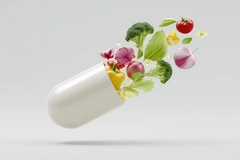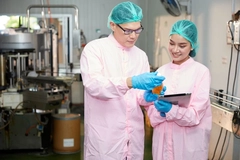Storytelling puts spotlight on sustainably sourced hero ingredients

03 Mar 2020 --- In the context of sustainably sourced nutritional ingredients, effective storytelling opens an essential avenue for companies to convey information about a product’s traceability and naturality. On the subject of eco-conscious sourcing practices for hero ingredients, NutritionInsight speaks to industry experts to explore how an effective communication strategy can help spotlight ingredient provenance and boost brand credibility.
Notably, “Storytelling: Winning with Words” crowns Innova Market Insights’ Top Ten Trends for 2020. As an example of how this trend can be leveraged to address consumer demand for traceability in health products, Dan Souza, Global Product Manager at Naturex (under Givaudan), details the sustainable sourcing of raw materials used in the production of Pacran and Flowens, which are sourced the heart of New England. Both are marketed as scientifically substantiated cranberry ingredients for nutritional purposes.
“Grown in bogs, cranberries come with their own unique cultivation story, where water plays the central role. Water is used not just to grow cranberries, but also for harvesting. The fruits are moved from one area of the farm to another through a series of pumps, canals and waterways. At the end of the harvest season, the water is released from the system for complete recycling,” he explains.
 Grown in bogs, cranberries sourced for use in nutritional products come with their own unique cultivation story.Hops are used by Naturex in the production of another clinically substantiated ingredient: Lifenol. With fields growing for about 25 years, long lasting partnerships are crucial to hops cultivation, notes Souza. In this context, storytelling plays a role in communicating to consumers the various aspects of food safety, in addition to product quality and traceability.
Grown in bogs, cranberries sourced for use in nutritional products come with their own unique cultivation story.Hops are used by Naturex in the production of another clinically substantiated ingredient: Lifenol. With fields growing for about 25 years, long lasting partnerships are crucial to hops cultivation, notes Souza. In this context, storytelling plays a role in communicating to consumers the various aspects of food safety, in addition to product quality and traceability.
“Our German growers work with integrated agricultural practices and technology has a role to play. For example, farmers need to be very responsive and quick to take measures in case of disease propagation. Phytosanitary treatments are reduced to a minimum through the use of mobile phone alerts sent by technical organizations that support farmers. All field operations are registered in crop books and batches are sampled and analyzed to ensure quality and full traceability from field to hop pellets.”
Traceability is an integral component to communicating product sustainability. As another example of its integration into brand storytelling, Souza cites Naturex’s SWEOAT Bran, rich in beta glucans. The health claim-approved oat fiber ingredient is extracted from oats grown in Sweden and Finland in line with sustainable agricultural practices.
“There are tight restrictions on the use of pesticides and herbicides and full traceability is guaranteed. Thanks to a proactive and transparent relationship with growers and farmers’ co-operatives, every batch of SWEOAT bran can be traced back to the field where it was harvested. Naturex contracts farmers one to two years in advance, ensuring a secure and sustainable supply in the face of growing worldwide demand for oats,” he further outlines.
Meanwhile, vitamin C-rich acerola is sourced by Givaudan in Northeast Brazil, where it is an “integral part of the local economy,” offering more opportunities for storytelling. “About half of the fruits are harvested when they are green and their vitamin C content is highest. Therefore, acerola requires careful collection practices involving manual picking skills and strong expertise,” says Souza.
“The small-scale farms that produce acerola are family-run businesses with farmers working in close collaboration with agronomic experts to ensure good agricultural practices that favor grassing while banning herbicides. Field operations are registered in crop books and close attention is paid to preserving surrounding biodiversity,” he adds.
A unique set of challenges
Sustainable sourcing of botanical ingredients comes with its own unique set of challenges, stresses Timothée Olagne, Global Category Director of Nutrition Ingredients at Naturex. “Ingredient manufacturers need to ensure Good Agricultural and Collection Practices (GACP) adherence among growers, who can potentially number in the hundreds or even thousands. For botanical ingredients that tend to rely on small-scale farmers using traditional methods, monitoring and working closely with suppliers is key.”
 Sustainable sourcing of botanical ingredients comes with its own unique set of challenges.Secondly, Olagne notes it is important to reduce transport between harvesting and production sites to the extent possible. “If production isn’t done locally, efforts must be made to achieve as much processing onsite as possible (for example certain botanicals can be sun-dried directly in the fields before being transported elsewhere, reducing the weight of the materials and foregoing a potential additional transport step).”
Sustainable sourcing of botanical ingredients comes with its own unique set of challenges.Secondly, Olagne notes it is important to reduce transport between harvesting and production sites to the extent possible. “If production isn’t done locally, efforts must be made to achieve as much processing onsite as possible (for example certain botanicals can be sun-dried directly in the fields before being transported elsewhere, reducing the weight of the materials and foregoing a potential additional transport step).”
In the context of sustainable saffron sourcing for nutritional supplements, Nutraceutical company Pharmactive Biotech Products flags particular challenges in saffron sourcing. These include mitigating the use of fertilizers and lowering energy consumption during the extraction process. To meet these ends, Pharmactive has developed and patented a new extraction process (AFF ON Cool-Tech) which does not use industrial solvents and applies low temperatures to avoid energy waste.
Saffron is a key ingredient in Pharmactive’s Affron product, made using saffron extract from high-performance liquid chromatography. The extract is standardized to produce Lepticrosalides, the bioactive compounds that help with maintaining relaxation; mental and physical balance; and a positive mood.
“In terms of saffron extracts for the food supplements industry, we can confirm that different synthetic solvents and other substances are often used in the extraction process – which can be potentially harmful for the environment – and that there is a need to lower the amount of energy used in this process,” says Julia Díaz, Head of Marketing at Pharmactive.
Another key ingredient is ABG10+ (aged black garlic extract), which is produced via a natural Maillard reaction through Pharmactive’s proprietary process. It consists of controlled temperature and relative humidity, which eliminates the unpleasant sensorial garlic sensorial characteristics of garlic while increasing the content in bioactive compounds. In this case, the raw material is organically produced very close to the manufacturing plant to avoid long transports, no additives or preservatives are used. In addition, there is no burning of any kind during the process (which can be fraudulently used to elevate the dark colour of the extract).
Shifts in global appetite for sustainability
Consumer appetite for sustainable foods has long been clear but suffered a brake during the global economic crisis, notes Díaz of Pharmactive. “With the economic improvement, we attended to an increase in the interest of consumers in eco-friendly sourcing, especially driven by the youngest ones: Generation Z and Millennials, who are more aware of the global necessity of a change and focus on physical and healthy appearance.”
There is little doubt, however, that consumer appetite for sustainable foods will slow in years to come and industry is bound to use brand storytelling to communicate various sustainability messages in the future. “Consumers are looking for products that are both good for their health and good for the planet,” says Olagne of Naturex.
“Evidence of this can be seen in the F&B market, where plant-based meat substitutes are gaining market share, as well as in health and wellness markets, where consumers are increasingly expecting increased transparency, which includes understanding the techniques used to produce the raw materials used in their food supplements,” he concludes.
By Benjamin Ferrer












